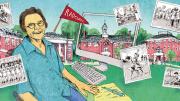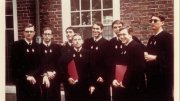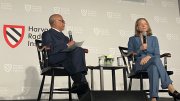Almost 70 years after graduating from Radcliffe, Jewelle Taylor Gibbs ’55 still keeps in touch with classmates across the country. She fondly recalls memories of the women’s liberal-arts college, founded in 1879 as the counterpart to the then all-male Harvard College, as a place where she was always “learning how to be a leader,” despite administrators who too often assumed “we would all get married and be happy for the rest of our lives with our husbands’ careers.” “I am still emotionally connected to Radcliffe, not to Harvard, that’s true. And I still feel a lot of pride,” she told an interviewer for the Radcliffe College Alumnae Oral History Project. “I still give; my annual contribution always goes to the Radcliffe Institute.”
Gibbs is among more than 50 women who have already contributed to the innovative oral-history project, which aims to chronicle the “lived experiences” of undergraduates from the 1940s through the class of 1979— the last group of women accepted through Radcliffe’s admissions office, even though the college’s official merger with Harvard took another two decades. The project was launched in 2019 by Alice Abarbanel ’66, a clinical psychologist in Berkeley, California, and a member of the Radcliffe Club of San Francisco, the last independent Radcliffe alumnae club in the world. She and a small team of alumnae volunteers have so far gathered stories from women representing classes from 1941 through 1962—the last year Radcliffe issued a separate, Latin diploma to its graduates.
What makes the project unique, Abarbanel says, is its emphasis on the lived experiences—and its sensitive timeline. The oldest interviewee, Evelyn Kravitz Richmond ’41, is 99. Louise Untermyer Frankel ’49 was interviewed in January 2020, and died, at age 92, within weeks of telling her Radcliffe stories. The Yale Law School graduate remembered smoking with friends in Cabot Hall (now part of Cabot House), playing bridge with classmates, and eventually refusing a Harvard diploma. (They were offered later to women of her era, but, she told Abarbanel, she was “perfectly happy” with her Radcliffe equivalent.)
The potential importance of documenting these stories, for both personal and historic reasons, occurred to Abarbanel during a meeting of the Radcliffe club. At 74, she was among the youngest members of the tenacious group. “Why are we in a separate Radcliffe Club?” she recalls thinking. “Why don’t we go to the Harvard Club?” She began to wonder what life was like for the generations of women educated at this separate institution, what it meant then, and how they now perceive their choices and experiences. “I started out curious,” she says, “and I now am moved, grateful for the conversations, and even more aware of the urgency to record this history.” When she reached out to the Radcliffe Institute’s Schlesinger Library on the History of Women in America, she says, she found scant information about the daily lives of Radcliffe alumnae who were students during the second half of the twentieth century. She aims to fill that void through audio recordings and transcripts from the interviews, which will be digitally archived and made publicly accessible at the library.
Abarbanel, a longtime psychotherapist, says interviewing alumnae came naturally to her. “I’m deeply curious about the interaction of life history and the historical moment,” she explains, “stemming from my Soc Sci 139 class with Erik Erikson.”
Within the histories conducted so far, Abarbanel has noticed some common themes: the lack of respect and support for Radcliffe students, including sexism and limited access to academic or other facilities on campus; and the homogeneity of the student body. The interviews have also captured important information about how Radcliffe undergraduates experienced and engaged in various phases of the national women’s movement, and underlined many of the positive features of living and learning among some of the nation’s brightest women: a shared sense of camaraderie, gratitude for the lasting friendships made, and pride in the speakers’ abilities to make the most of their college education, despite their unequal status.
Sexism confronted Mary Davidoff Houts ’58, who said that she wanted to enter the field of ecology, but was discouraged by a man in the biology department who warned her that “it’s a very bad field for women.” The retired museum administrator is active in environmental causes. So, too, is former government concentrator Ellen Wood Barth ’58, who was disheartened when a tutor, assuming she didn’t know what habeas corpus meant, told her she couldn’t attend law school. “I saw [his comment] as saying that’s not a career path that you’re equipped or allowed to pursue,” she recalled. Judith Frost Levine ’51, another government concentrator, was steered away from law school by a brother; she earned a degree in social work instead.
But support could be limited at Radcliffe itself. “I never had the feeling there was anybody in the University, in the College, that was really interested in who I was or what I was doing,” said Mary Taylor Simeti ’62, who would become a prolific food and travel writer specializing in Sicilian medieval and culinary history. Katharine Gratwick Baker ’59, a music concentrator who became an organizational consultant, put it this way: “There was no acknowledgment of anything you did in a practical way...certainly you got no credit for it, no recognition or encouragement at all.” Jewelle Gibbs—professor emerita at the UC Berkeley School of Social Welfare, where a multicultural practice and policy fellowship is named for her—specifically noted the lack of counseling services: “There weren’t many mental-health resources. It was one of the biggest weaknesses of that school. And everybody will tell you, they didn’t have good psychological, they didn’t have good vocational, counseling.”
With respect to diversity, Abarbanel points out that at Radcliffe “in the 1940s and 1950s, it was diverse to meet somebody who was Jewish, it was diverse to meet somebody who went to a public school if you went to a private school.” There was also a relative lack of geographic variance in the 1940s, she adds; most students commuted from homes in and around Boston.
In her research and project work, Abarbanel has especially sought to illuminate the narratives of Radcliffe alumnae of color. Gibbs was the only black student in her class of 1955. She told Abarbanel she was assigned to room with the only other black student in the class, who never arrived at Radcliffe.
Gibbs was involved in racial-justice efforts on campus, and helped desegregate rooming through the Radcliffe Association on Minority Problems (RAMP), which she called “the local chapter of the NAACP.” (Her 2014 book, Destiny’s Child: Memoirs of a Preacher’s Daughter, explores her family’s roots and contributions to the U.S. civil-rights movement).Retired federal attorneyMarian Clae Bennett ’66, Abarbanel’s classmate, was one of eight black students in what she described as a “breakthrough class”—because, she told Abarbanel, there was only a single student of color in the sophomore, junior, and senior classes when they were first-year students.
At Radcliffe, the students of color and Jewish students were minorities within the larger minority of Radcliffe students as a whole. “’Cliffies” took separate, women-only classes until faculty shortages during World War II forced gradual change. “Well, we used to joke about the fact that we had the same courses that they had at Harvard,” recalled nonagenarian Evelyn Richmond. “We had the same professors giving them. They used to…walk across the [Common] to Radcliffe, and give us the same lecture—except for the dirty jokes.” In her day, she told Abarbanel, there was a single Radcliffe Room in Widener Library. “If we wanted a book, we requested it, and they would order it and bring it to the room…the only place we could be” in the library. Women were expected to use their own library, in Radcliffe Yard. Gibbs, on campus 14 years later, also remembered being barred from some libraries, including Lamont (opened in 1949, it first admitted women in 1967). By the time she arrived, though, Radcliffe and Harvard students were taking classes together.
As a member of the class of 1959, Katharine Baker told an interviewer, the oral histories from the mid 1940s to the mid 1960s reflected a crucial period both in Radcliffe’s trajectory and in the broader history of women in America. She viewed her class as a “transitional generation.” “Maybe there are some parallels here about women emerging from the lives that our mothers and grandmothers had into the kind of professional lives that our daughters and granddaughters now have,” she said. “We were kind of right in the middle of that.” Gibbs, who graduated four years earlier, had a different perspective. She did not identify with the burgeoning feminist movement of the 1960s, she said, because it was largely dominated by white women who ignored working-class women’s and black women’s concerns.
Abarbanel herself arrived in Cambridge in 1962, but took a year off halfway through college. Returning to campus, she witnessed the emergence of feminism and its seismic impact: the place was like a “different school,” she says, “in terms of the music, the way women talked about life and goals, civil rights, Vietnam. My memories therefore have two historical chapters, two different Radcliffes.”
Despite reporting shortcomings of life at the Quad, the alumnae have also said they benefited from opportunities. “People knew that Radcliffe was the women’s college of Harvard, and you had to be especially bright to go there,” Evelyn Richmond told Abarbanel. The sole Radcliffe student in her year selected to assist a psychology professor with a research project, she said her degree helped her impress employers and find jobs, including one with cultural anthropologist Margaret Mead, S.D. ’73.
Two decades later, Mary Simeti would become one of the first women to be president of a Harvard-Radcliffe undergraduate activity, she noted in her interview: as head of the Phillips Brooks House Association. Jewelle Gibbs was active in student government and the Radcliffe Choral Society, and recalled feeling part of a community when it came to extracurricular and social endeavors. “I made some very close friends that have been lifelong friends,” she reported. “And they are all white. And I have had contact with two or three of them recently.…And that was good, too, to have friends across racial barriers, so to speak.”
Abarbanel hopes to conclude the first phase of the project this summer, before starting to collect stories from the classes of 1963 through 1979. “We look forward to launching phase two in the fall,” she explains. “Our two biggest challenges are, first, to find and identify a broad and diverse sampling that represents racial, ethnic, socioeconomic, and geographic diversity. Our second challenge is to conduct fundraising to support the effort.”
The interviews to date, she thinks, have shed light on a fascinating range of personal experiences relative to a wider historic context and reaffirmed for her the importance of being part of the only remaining independent Radcliffe Club. “The gathering of women,” she says, “provides a kind of support and community that does not happen in co-ed alumni gatherings.”
The alumnae stories, more intimately layered than strict historic research, represent a shared communication, she explains. Both interviewers and interviewees benefit from exploring the “lifelong impact” of their experiences, as individuals and members of a community. “It is a personal conversation and connection. The older alumnae appreciate and express gratitude for these conversations. My getting to know these women has moved and inspired me.” All eight volunteer interviewers, whose classes range from 1966 to 2012, “feel as I do,” she adds. “The alumnae are vibrant, articulate women engaged in remembering and sharing their experiences.”
Lucille Block Poskanzer ’55 said her conversation with Abarbanel was the first time someone had expressed interest in her Radcliffe experience, and she appreciated the opportunity to reflect on the institution and that time in her life. “The memory of Radcliffe and the importance of Radcliffe to so many women’s lives is being lost,” the retired pediatric genetic counselor said when interviewed for this article. “I don’t think that undergraduates nowadays know much about Radcliffe. You don’t read about it, you don’t hear about it; it’s all about Harvard.”
Poskanzer hopes information from the oral-history project will be widely disseminated. The Schlesinger Library ultimately does plan to make the oral histories fully accessible. “Undergraduate women definitely should read about it, but it shouldn’t stop there,” she says. “I think the men need to know about it. I think it’s important information for everyone. It’s part of Harvard’s history that many seem to have forgotten.”









